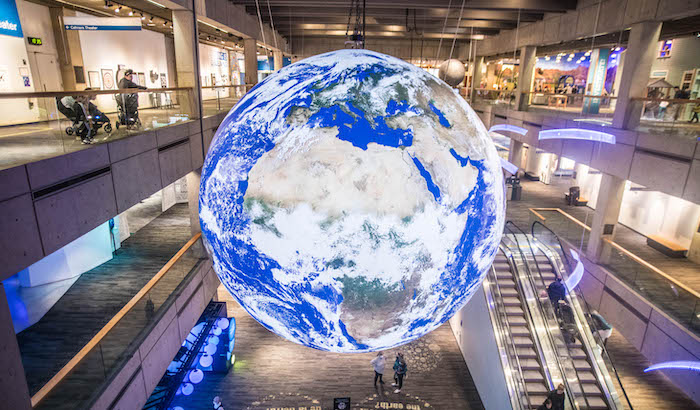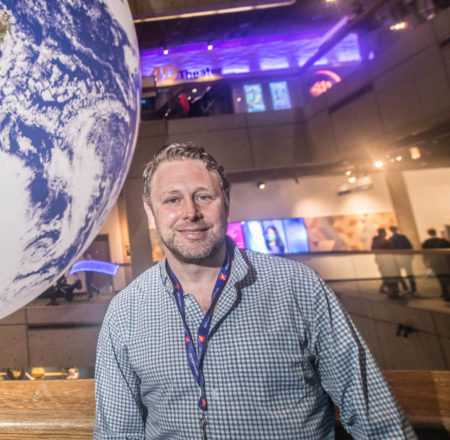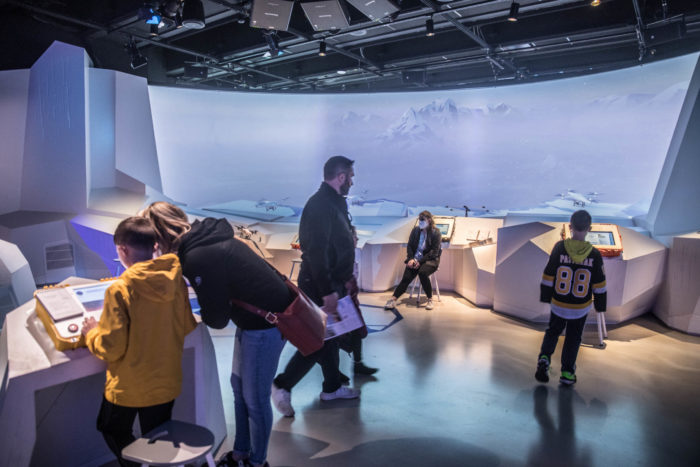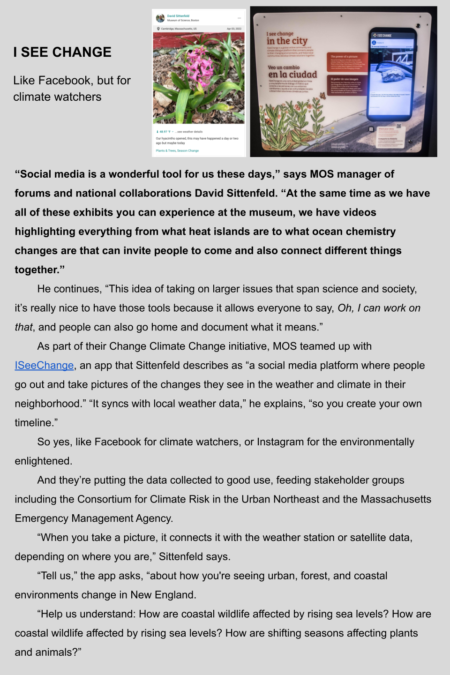
BY DIGBOSTON X MUSEUM OF SCIENCE
PHOTOS BY DEREK KOUYOUMJIAN
A spoonful of sugar (and science) to help the medicine go down and the earth go ’round
One major difference between a newspaper and a major museum is that the former doesn’t typically consider the fun factor. While not everything in the pages of DigBoston is serious, and we take pride in our longtime tagline—humor, news and nightlife—when something’s sad or perhaps existentially exhausting, we don’t feel it should be our duty to dollop out spoonfuls of sugar to help the medicine go down smoothly. And we make no apologies for doing our job, even if it makes readers sad or upset.
With some exceptions, museums have a different arrangement with the public. They’re largely expected to show visitors a phenomenal time, all while providing some kind of eye-popping adventure and simultaneously teaching you something. Bostonians are fortunate in that many of our local institutions fit that description, among them the Museum of Science, which straddles the fantastic, galactic, and didactic as naturally as it does the Boston and Cambridge border.
The Dig covers climate change and the environment frequently, not just around Earth Day. But when the opportunity was presented for us to collaborate with MOS for the annual event, we showed up at their door to take it all in. They’re back to welcoming thousands of visitors on busy days, and their current ongoing Change Climate Change takeover of the building was designed for more than just the families and grade schoolers who typically fill their exhibits. That includes us. And you, too, if we’re ever going to make progress on the climate front.
We had David Sittenfeld, manager of forums and national collaborations for MOS, physically walk us through the multiple exhibits that constitute Change Climate Change, a variety ranging from New England Climate Stories that explore live animals and natural history, to an immersive multimedia experience that drops you deep into the flooded heart of Venice, Italy under the worst and best possible future scenarios. We promise, he makes it all sound a lot more fun—and hopeful—than we ever could on our own.
“People are a big part of this story. It provides a really nice window to talking about a mix of adaptation and mitigation strategies,” Sittenfeld says. “In the past, it was hard to talk about both of those at once, but by doing it with a big initiative that involves the entire museum, plus community partners and social media as well as virtual tie-ins, it allows us to talk about all the ways people can be a part of the solution.”

In the beginning …
“The museum has been doing things on climate change and other environmental issues for a really long time,” Sittenfeld explains. “It’s part of what we do. But because the world is really focused on this right now, the museum is really focused on thinking about how to not only address content ourselves, but to bring in things our community and civic partners are doing out there in a number of ways. It’s a big thing under our new president, figuring out how we can showcase the innovation and work and equity and all that stuff people are doing in Boston, where you have so much thought power.
For their current setup, he adds, “The big initiative we have brings together highlighting what we know about climate change with what we still don’t know. We know that there’s a problem, we know that we need to address this problem, we know that it affects people disproportionately, and we know that we are working on solutions.”
“We want people to think about the ecosystems that are there and the natural strategies that people have been using for thousands of years that can help budget where we need to go. You can tell the whole story when the museum takes something on this way.”
If you build it …
In the Arctic Adventure exhibit, you can see and touch as a participant—tiptoeing atop a melting ocean, searching for wildlife with a gamified drone simulator, or pressing your paw against the frozen wall of an ice cave. The MOS has long been known for going further than simply hanging frames on the wall and playing educational videos, but for Change Climate Change they removed any and all boundaries between the exhibits and visitors.
“These are heavy topics,” he explains. “How do you make it fun and engaging and hopeful? That’s been our question, and you find those different pockets that we have created as our ongoing answer.”

A multilateral approach …
“The museum is sort of trying to have us think about how to address this issue in a number of ways,” Sittenfeld says. “There are a lot of channels and ways of delivering the content. Some of it is digital material, plus there are exhibits, there are programs on the floor.
“We intentionally think about devices and strategies that will work for a variety of audiences. It’s very different talking about impacts of climate change to a small child who may be visiting and is excited to see a tree frog in a Museum of Science exhibit and an adult that comes, but at the same time we want to provoke that hope in everyone. It looks different depending on the format, and we’re trying to have a variety of experiences because it allows people to have different touchpoints.”
The manager of forums and collaborations continues, “There’s sort of an intentional mix of things that are in our backyard and things that are global. There’s one exhibit where you see all about how climate change is affecting forest ecosystems and forest environments in coastal areas, because you probably go to those. Even if you’re just visiting New England for the weekend and come to the museum, you know about those things and you can think about them in that context. But then you go next door and there is an exhibit about resilient Venice, and you learn about how climate change is affecting social systems including large cities and endangered heritage sites.”
Engaging change …
“We’re giving people a sense that they can contribute in a number of ways,” Sittenfeld says. “They can think about where climate change is affecting them in their community, but also they’re learning what can be done about it. That’s the defining message—that people can do something about this. We can change the conversation.
“Climate change requires a social response—everybody needs to be a part of it, you can’t fix it yourself—but also, everyone is impacted by it and we know that everyone is impacted by it differently. Fortunately, there’s a spectrum of participation that was harder to do before. Our theory of action is that decisions about what to do about this problem are better when everyone is part of the discussion. A lot of the work that we’re doing in our programs—on the stages, as well as the interpretations and the exhibits—are kind of all about the fact that to address this problem we need everyone on board, and we need everyone’s perspectives and values. Science can’t really tell us what to do, it can just tell us that we have these issues and we’re trying to address them.”
“Changes are happening in our communities, and the question is, Are we going to think about climate change as we make those changes, or not? And as we think about the changes, we have an opportunity to address needs that can make our communities more equitable and resilient at the same time. Those are not decisions that science has all of the purview over. Science has to be part of the discussion, but when we talk about how to reengineer neighborhoods or how we’re going to change our public transportation system, we want people thinking about how every decision that we make should address peoples’ values.
“We really want to give people a sense of agency and hope that there is stuff they can do individually and also that they can have a voice in what society is going to do.”
Like the issue of climate change, Sittenfeld says the MOS’s commitment to engaging on this front is “not going away.” Instead, “It’s going to be a permanent step up. It’s going to be a major part of our work going forward.”
More information, resources, and tickets at mos.org/climate-change. Rise Up Boston: A Climate Event on Sat., April 30 and Sunday, May 1. More at mos.org/rise-up-boston
Dig Staff means this article was a collaborative effort. Teamwork, as we like to call it.


